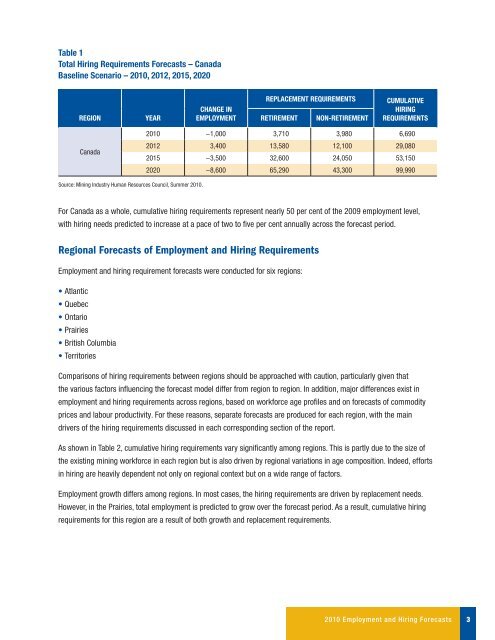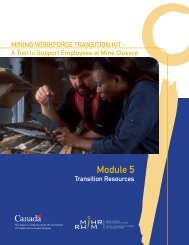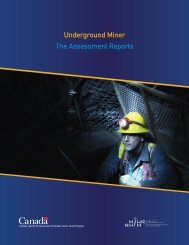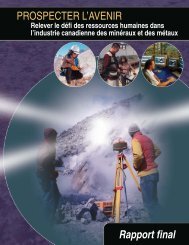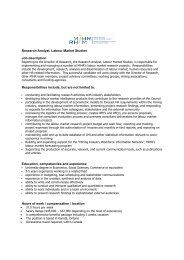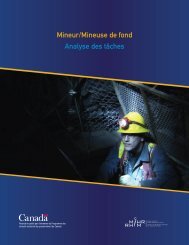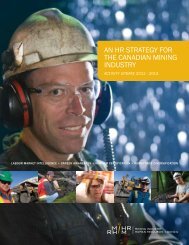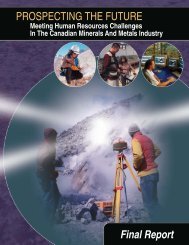Canadian Mining Industry Employment and Hiring Forecasts - MiHR
Canadian Mining Industry Employment and Hiring Forecasts - MiHR
Canadian Mining Industry Employment and Hiring Forecasts - MiHR
You also want an ePaper? Increase the reach of your titles
YUMPU automatically turns print PDFs into web optimized ePapers that Google loves.
Table 1<br />
Total <strong>Hiring</strong> Requirements <strong>Forecasts</strong> – Canada<br />
Baseline Scenario – 2010, 2012, 2015, 2020<br />
REGION<br />
YEAR<br />
CHANGE IN<br />
EMPLOYMENT<br />
REPLACEMENT REQUIREMENTS<br />
RETIREMENT<br />
NON-RETIREMENT<br />
CUMULATIVE<br />
HIRING<br />
REQUIREMENTS<br />
Canada<br />
2010 −1,000 3,710 3,980 6,690<br />
2012 3,400 13,580 12,100 29,080<br />
2015 −3,500 32,600 24,050 53,150<br />
2020 −8,600 65,290 43,300 99,990<br />
Source: <strong>Mining</strong> <strong>Industry</strong> Human Resources Council, Summer 2010.<br />
For Canada as a whole, cumulative hiring requirements represent nearly 50 per cent of the 2009 employment level,<br />
with hiring needs predicted to increase at a pace of two to five per cent annually across the forecast period.<br />
Regional <strong>Forecasts</strong> of <strong>Employment</strong> <strong>and</strong> <strong>Hiring</strong> Requirements<br />
<strong>Employment</strong> <strong>and</strong> hiring requirement forecasts were conducted for six regions:<br />
• Atlantic<br />
• Quebec<br />
• Ontario<br />
• Prairies<br />
• British Columbia<br />
• Territories<br />
Comparisons of hiring requirements between regions should be approached with caution, particularly given that<br />
the various factors influencing the forecast model differ from region to region. In addition, major differences exist in<br />
employment <strong>and</strong> hiring requirements across regions, based on workforce age profiles <strong>and</strong> on forecasts of commodity<br />
prices <strong>and</strong> labour productivity. For these reasons, separate forecasts are produced for each region, with the main<br />
drivers of the hiring requirements discussed in each corresponding section of the report.<br />
As shown in Table 2, cumulative hiring requirements vary significantly among regions. This is partly due to the size of<br />
the existing mining workforce in each region but is also driven by regional variations in age composition. Indeed, efforts<br />
in hiring are heavily dependent not only on regional context but on a wide range of factors.<br />
<strong>Employment</strong> growth differs among regions. In most cases, the hiring requirements are driven by replacement needs.<br />
However, in the Prairies, total employment is predicted to grow over the forecast period. As a result, cumulative hiring<br />
requirements for this region are a result of both growth <strong>and</strong> replacement requirements.<br />
2010 <strong>Employment</strong> <strong>and</strong> <strong>Hiring</strong> <strong>Forecasts</strong><br />
3


